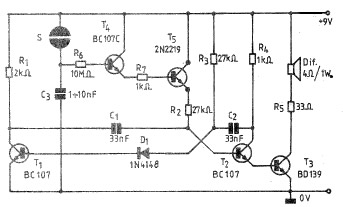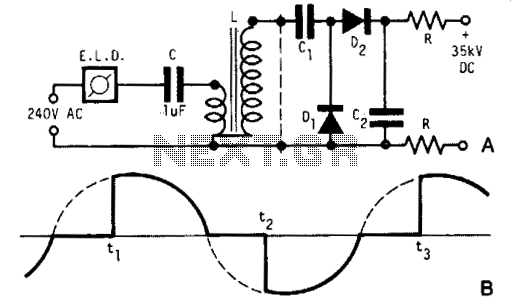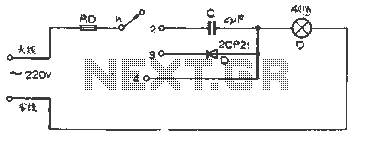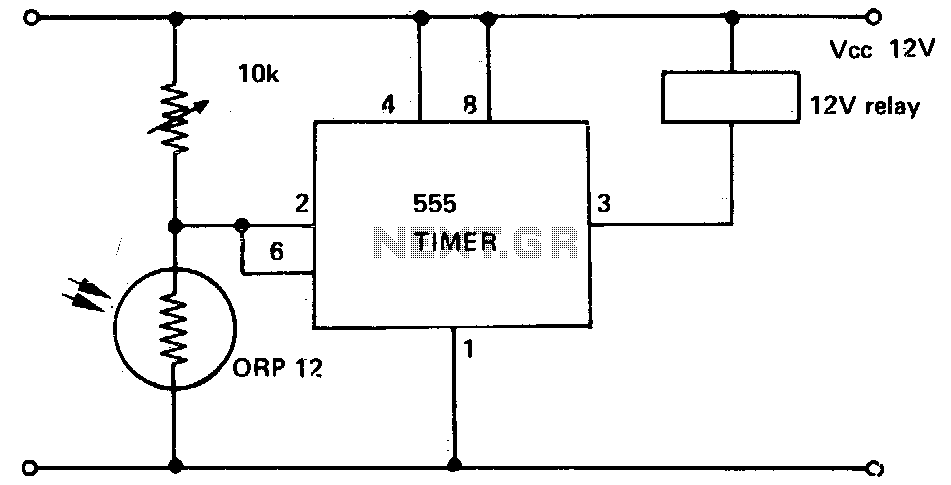
Simple optical switchs
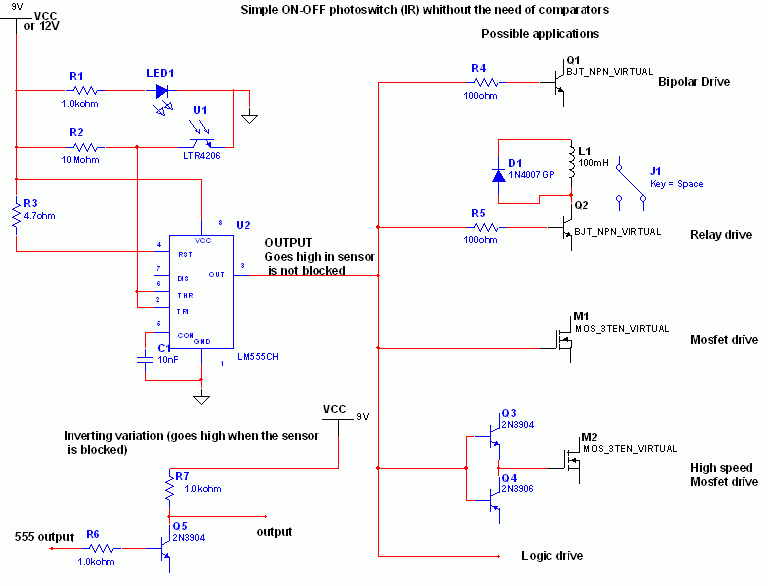
When the phototransistor is struck by infrared (IR) light, it begins to conduct, causing the voltage across a 1 MΩ resistor (chosen arbitrarily) and the phototransistor to drop from VCC to lower values. When this voltage falls below VCC/3, the 555 timer is triggered, transitioning its output from 0 to VCC. The amount of light required to reduce the collector voltage of the phototransistor to VCC/3 is determined by the resistor value (Vdrop = Icollector * R). Therefore, if Vdrop equals 2 * VCC/3, the required resistance to set the current threshold is R = 2 * VCC / (Icollector * 3). High-sensitivity phototransistors necessitate a smaller resistor, while less sensitive ones require a higher resistance value. A trimmer can also be employed to precisely adjust the threshold level. The timing of the phototransistor is not critical. The 555 timer has a high current capability and can drive various devices, including bipolar transistors, relays, combinations of bipolar transistors and relays, MOSFETs, or provide a logic output. If triggering is needed when the gate is blocked (for example, in a burglar alarm or a multistage coilgun), the output must be inverted. This can be achieved using a small bipolar transistor configured in an inverting setup or by swapping the positions of the phototransistor and the resistor, causing the voltage to drop below VCC/3 when blocked. The formula to determine the resistance required to turn off at Icollector is R = VCC / (Icollector * 3).
The circuit described utilizes a phototransistor in conjunction with a 555 timer integrated circuit (IC) to create a light-sensitive triggering mechanism. The phototransistor serves as a light sensor, responding to IR light. Upon detecting sufficient IR light, the phototransistor conducts, resulting in a voltage drop across the connected resistor. The 555 timer monitors this voltage, and when it falls below the specified threshold (VCC/3), it activates its output.
The choice of the resistor value is critical in setting the sensitivity of the phototransistor. A lower resistance value is suitable for high-sensitivity phototransistors, allowing them to trigger the 555 timer with minimal light input. Conversely, a higher resistance is appropriate for less sensitive phototransistors, requiring more light to reach the threshold. The use of a trimmer potentiometer enables fine-tuning of this threshold, allowing for greater flexibility in various applications.
The 555 timer's output capabilities make it suitable for driving a wide range of devices. Its high current output can control relays or transistors, enabling the circuit to switch larger loads or provide logic signals based on the detected light levels.
For applications where the output needs to be inverted (e.g., triggering an alarm when light is blocked), the circuit can be modified using a bipolar transistor configured as an inverter. This allows the system to respond appropriately to changes in light conditions, enhancing its functionality in security or control systems.
Overall, this circuit design is versatile and can be adapted for various applications requiring light detection and response, emphasizing the importance of component selection and configuration in achieving the desired performance.When the phototransistor is stroken by IR light it conducts and the voltage between the 1Mohm resistor(arbitrary) and the phototrans drops from VCC to lower values. When the voltage drops lower than VCC/3 the 555 is triggered and goes high (from 0 TO VCC). The amount of light that strike the phototrans necessary to bring his collector to VCC/3 is determined by the resistor (Vdrop = Icollector * R, so, if Vdrop= 2*VCC/3, the resistance needed to set the threshold on current is R=2*VCC/(Icollector*3). High sensibility phototrans would need a smaller resistor, and weaker phototransistors higher value resistor, you can also use a trimmer to set the on threshold level with precision.
The time of phototransistor isn`t critical. The 555 has high current capability and can drive various devices, such as Bipolars, relays, bipolars+relays, mosfets, mosfets + totem pole, or give a logic output (see pic). In case you need to trigger something when the gate is blocked (for example a burglar alarm, or a multistage coilgun) you need to invert the output, which is accomplished using a small bipolar transistor wired in an inverting setup (see pic) or swapping the positions of phototransistor with the resistor, so the voltage will drop under VCC/3 when blocked: The formula to determine the resistance to turn off at Icollector is R=VCC/(Icollector*3).
🔗 External reference
The circuit described utilizes a phototransistor in conjunction with a 555 timer integrated circuit (IC) to create a light-sensitive triggering mechanism. The phototransistor serves as a light sensor, responding to IR light. Upon detecting sufficient IR light, the phototransistor conducts, resulting in a voltage drop across the connected resistor. The 555 timer monitors this voltage, and when it falls below the specified threshold (VCC/3), it activates its output.
The choice of the resistor value is critical in setting the sensitivity of the phototransistor. A lower resistance value is suitable for high-sensitivity phototransistors, allowing them to trigger the 555 timer with minimal light input. Conversely, a higher resistance is appropriate for less sensitive phototransistors, requiring more light to reach the threshold. The use of a trimmer potentiometer enables fine-tuning of this threshold, allowing for greater flexibility in various applications.
The 555 timer's output capabilities make it suitable for driving a wide range of devices. Its high current output can control relays or transistors, enabling the circuit to switch larger loads or provide logic signals based on the detected light levels.
For applications where the output needs to be inverted (e.g., triggering an alarm when light is blocked), the circuit can be modified using a bipolar transistor configured as an inverter. This allows the system to respond appropriately to changes in light conditions, enhancing its functionality in security or control systems.
Overall, this circuit design is versatile and can be adapted for various applications requiring light detection and response, emphasizing the importance of component selection and configuration in achieving the desired performance.When the phototransistor is stroken by IR light it conducts and the voltage between the 1Mohm resistor(arbitrary) and the phototrans drops from VCC to lower values. When the voltage drops lower than VCC/3 the 555 is triggered and goes high (from 0 TO VCC). The amount of light that strike the phototrans necessary to bring his collector to VCC/3 is determined by the resistor (Vdrop = Icollector * R, so, if Vdrop= 2*VCC/3, the resistance needed to set the threshold on current is R=2*VCC/(Icollector*3). High sensibility phototrans would need a smaller resistor, and weaker phototransistors higher value resistor, you can also use a trimmer to set the on threshold level with precision.
The time of phototransistor isn`t critical. The 555 has high current capability and can drive various devices, such as Bipolars, relays, bipolars+relays, mosfets, mosfets + totem pole, or give a logic output (see pic). In case you need to trigger something when the gate is blocked (for example a burglar alarm, or a multistage coilgun) you need to invert the output, which is accomplished using a small bipolar transistor wired in an inverting setup (see pic) or swapping the positions of phototransistor with the resistor, so the voltage will drop under VCC/3 when blocked: The formula to determine the resistance to turn off at Icollector is R=VCC/(Icollector*3).
🔗 External reference


